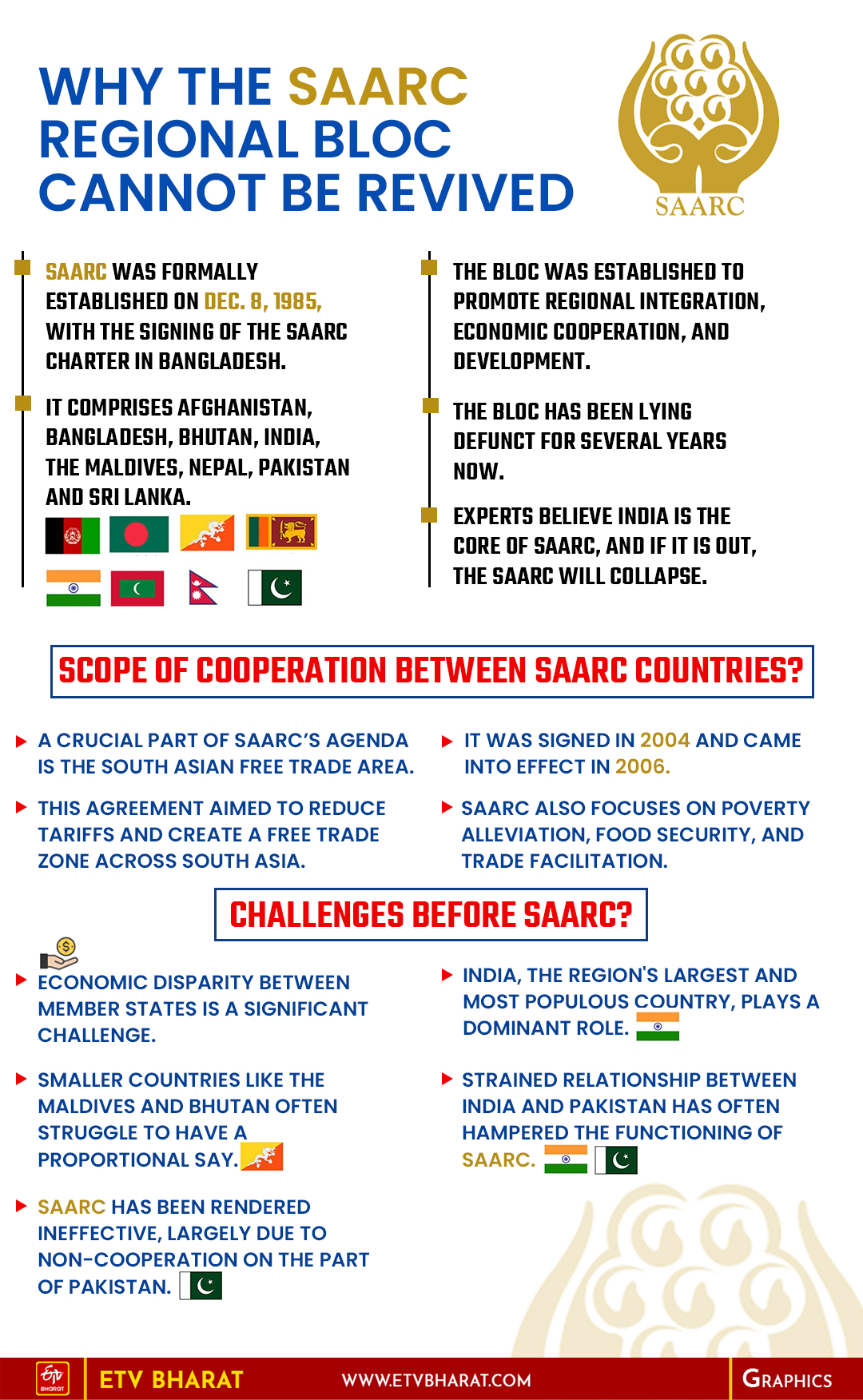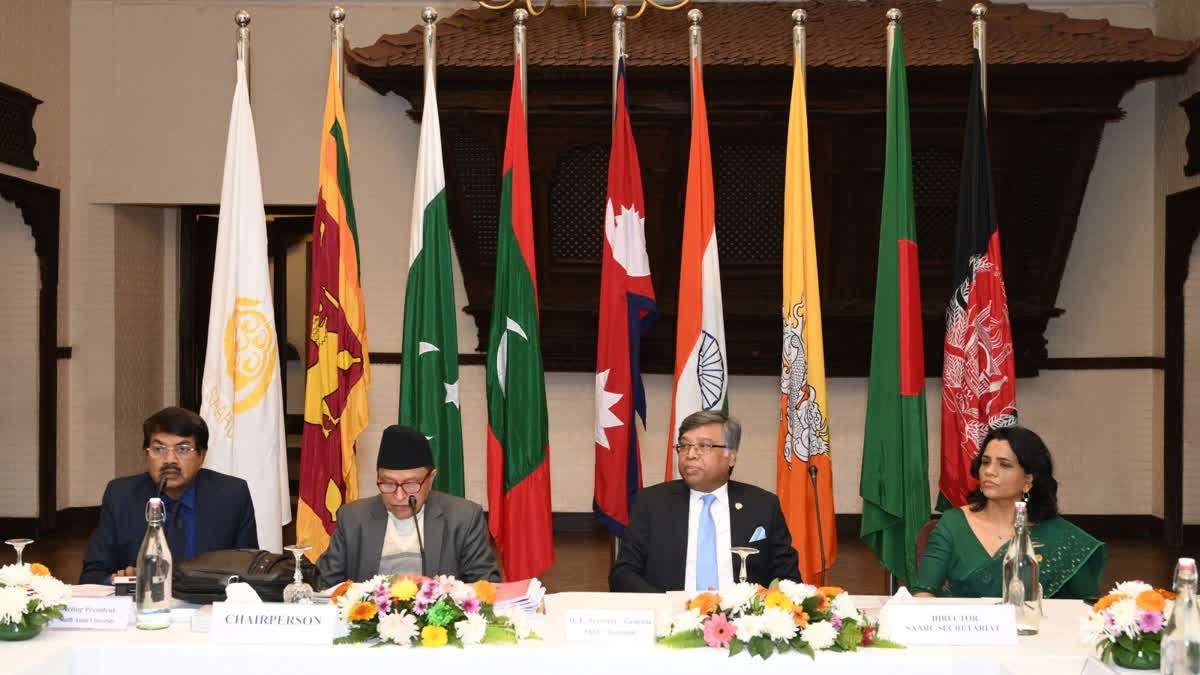New Delhi: Chief Advisor of the interim government Muhammad Yunus has been emphasising on the need to revive the South Asian Association for Regional Cooperation (SAARC) for regional cooperation and problem-solving.
In an interview in Dhaka, Yunus said that although SAARC was formed with a great cause, it now exists only on paper and is not functioning. “I have also taken the initiative to revive SAARC to enhance regional cooperation in South Asia,” he said in a separate televised address to the nation.
Established to promote regional integration, economic cooperation, and development, the SAARC regional bloc comprises Afghanistan, Bangladesh, Bhutan, India, the Maldives, Nepal, Pakistan and Sri Lanka.
So, can this regional bloc that has been lying defunct for nearly eight years now be revived?
Former Indian diplomat Amit Dasgupta, who served at the SAARC Secretariat in Kathmandu as Director Economic and Trade and as Special Assistant to the Secretary General from 1998 to 2002, does not believe so.
“India is the core of SAARC,” Dasgupta told ETV Bharat. “If you take India out, SAARC collapses.”
How did SAARC evolve?
The idea of cooperation among South Asian Countries was discussed in three conferences: the Asian Relations Conference held in New Delhi in April 1947; the Baguio Conference in the Philippines in May 1950; and the Colombo Powers Conference held in Sri Lanka in April 1954.
In the ending years of the 1970s, the seven inner South Asian nations that included Bangladesh, Bhutan, India, the Maldives, Nepal, Pakistan, and Sri Lanka, agreed upon the creation of a trade bloc and to provide a platform for the people of South Asia to work together in a spirit of friendship, trust, and understanding.

The idea of establishing an official framework for regional cooperation among South Asian nations was first introduced by former Bangladesh President late Ziaur Rahman through a letter he sent in May 1980 to other governments of the region. Noting that “current situation in South Asia and its immediate vicinity seems to call for a close consultations and exchange of views and ideas” Zia stressed on an ”urgent need for cooperation among the countries of the area for preserving peace and stability”.
SAARC was formally established on December 8, 1985, with the signing of the SAARC Charter in Dhaka, Bangladesh. The declaration was signed by then President of Bangladesh Hussain Ershad, then King of Bhutan Jigme Singye Wangchuk, then President of Pakistan Zia-ul-Haq, then Prime Minister of India Rajiv Gandhi, then King of Nepal Birendra Shah, then President of Sri Lanka JR Jayewardene and then President of the Maldives Maumoon Gayoom. The secretariat-general of SAARC was set up in Kathmandu.
In 2007, Afghanistan became the eighth member of the organisation, further expanding its reach across South Asia. As of 2021, SAARC collectively represents 3 per cent of the world’s land area, 21 per cent of the global population, and contributes 5.21 per cent (equivalent to $4.47 trillion) to the global economy.
What is the scope of cooperation between SAARC member countries?
A crucial part of SAARC’s agenda is the South Asian Free Trade Area (SAFTA), which was signed in 2004 and came into effect in 2006. This agreement aimed to reduce tariffs and create a free trade zone across South Asia. SAARC also focuses on other areas such as poverty alleviation, food security, and trade facilitation.
Overall, the areas of cooperation among SAARC member countries are economic, trade and finance; human resource development and tourism; agriculture and rural development; environment, natural disasters and biotechnology; social affairs; information and poverty alleviation; energy, transport, science and technology; and education, security and culture.
What are the challenges before SAARC?
The economic disparity between member states is a significant challenge. India, being the largest and most populous country in the region, plays a dominant role, while smaller countries like the Maldives and Bhutan often struggle to have a proportional say in the organisation’s affairs.
Despite the SAFTA agreement, intra-regional trade in South Asia remains among the lowest in the world, largely due to protectionist policies, infrastructure bottlenecks, and political mistrust. The strained relationship between India and Pakistan has often hampered the functioning of SAARC.
“I have seen myself, whenever India makes a proposal, Pakistan opposes it,” Dasgupta said while recalling his days in the SAARC secretariat.
SAARC has been virtually rendered ineffective as a bloc, largely due to non-cooperation on the part of Pakistan on issues like connectivity and counter-terrorism. After the cross-border terror attack from Pakistani soil on an army base at Uri in Jammu and Kashmir in September 2016, that year’s SAARC Summit scheduled to be held in Islamabad stood cancelled after other members of the group joined India in boycotting it. After that, no SAARC summit has been held till date.
Dasgupta said that the Pakistani establishment does not want any constructive relationship with India. “Pakistan is a failed economy and democracy is under threat there,” he stated. “Though India needs a flourishing neighbourhood for its own strategic reasons, it has stopped seeing SAARC as a platform for this. India’s own welfare depends on the welfare of its neighbours.”
Dasgupta drew a comparison between the Association of Southeast Asian Nations (ASEAN) and SAARC. “Unlike SAARC in which India is seen as the dominant country, there is no dominant country within ASEAN,” he said, adding that New Delhi will ask itself what did it get from SAARC.
At the same time, he said that though no new SAARC summit has taken place since the 18th summit held in Kathmandu in 2014, India has been engaging in bilateral trade with other SAARC countries. Trade between India and Pakistan is being done through third country mode via Dubai.
With the Pakistan economy going into a tailspin, India focussed on strengthening bilateral and sub-regional economic and trade ties with neighbouring countries through economic arrangements like the BBIN or the Growth Quadrangle (Bangladesh, Bhutan, Nepal, and India) or trilateral cooperation (Sri Lanka, the Maldives and India).
Meanwhile, with SAARC being defunct over the years, India has been giving more importance to the Bay of Bengal Initiative for Multi-Sectoral Technical and Economic Cooperation (BIMSTEC) in terms of regional cooperation. The BIMSTEC, which came into existence in 1997, comprises seven countries lying in the littoral and adjacent areas of the Bay of Bengal - Bangladesh, Bhutan, India, Myanmar, Nepal, Sri Lanka and Thailand. The bloc brings together 1.73 billion people and has a combined GDP of $5.2 trillion as of 2023.
Membership in the bloc allows India to engage more with the extended neighbourhood in Southeast Asia under New Delhi’s Neighbourhood First Policy via northeastern India. India’s membership of BIMSTEC also complements its increasing engagements with the ASEAN regional bloc under New Delhi’s Act East Policy. For India, BIMSTEC holds greater promise and has become a priority focus, according to Dasgupta.
“Inbuilt in the creation of SAARC was its failure due to various historical and geographical reasons,” Dasgupta asserted, justifying his conviction as to why this regional bloc cannot be revived.
Read More



